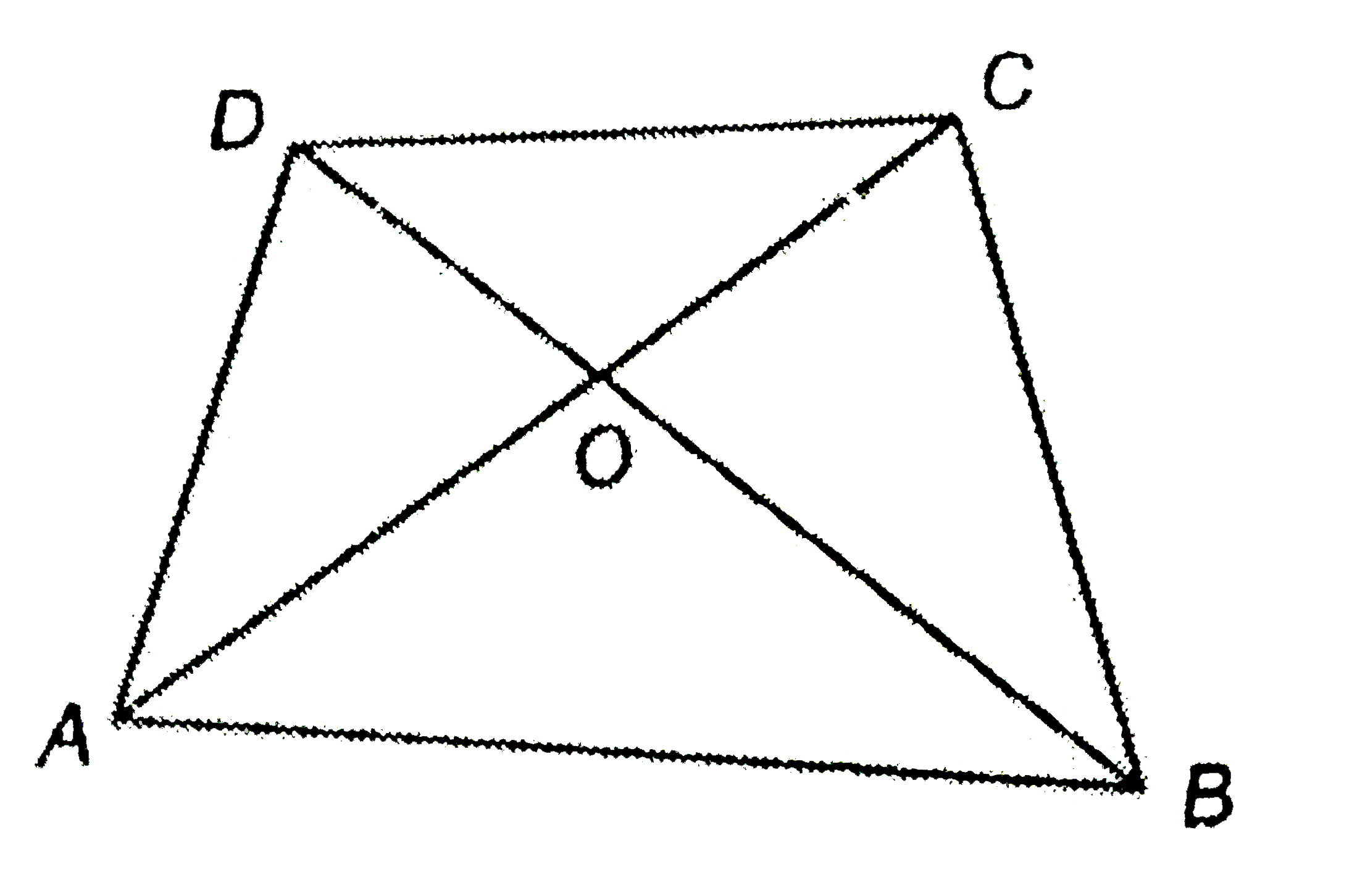ABCD is a quadrilateral whose diagonals are AC and BD. Which one of the following is correct?
A. −−→BA+−−→CD=−−→AC+−−→DB
B. −−→BA+−−→CD=−−→BD+−−→CA
C. −−→BA+−−→CD=−−→AC+−−→BD
D. −−→BA+−−→CD=−−→BC+−−→AD
The correct Answer is:B
To solve the problem, we need to analyze the given relations involving the position vectors of the vertices of the quadrilateral ABCD. The diagonals are AC and BD. We will check the validity of the relations one by one.
1. Identify the Position Vectors:
Let the position vectors of points A, B, C, and D be represented as →A,→B,→C,→D.
2. Write the Relations:
We need to verify the following relation:
→BA+→CD=→AC+→DB
3. Express the Vectors in Terms of Position Vectors:
- The vector →BA can be expressed as:
→BA=→A−→B
- The vector →CD can be expressed as:
→CD=→D−→C
- The vector →AC can be expressed as:
→AC=→C−→A
- The vector →DB can be expressed as:
→DB=→B−→D
4. Substitute into the Relation:
Substitute the expressions into the left-hand side (LHS) and right-hand side (RHS):
- LHS:
→BA+→CD=(→A−→B)+(→D−→C)=→A−→B+→D−→C
- Rearranging gives:
→A−→C+→D−→B
5. Compare with the RHS:
- RHS:
→AC+→DB=(→C−→A)+(→B−→D)=→C−→A+→B−→D
- Rearranging gives:
−(→A−→C)+−(→D−→B)
6. Check for Equality:
- From the LHS, we have:
→A−→C+→D−→B
- From the RHS, we have:
−(→A−→C)+−(→D−→B)
- It can be seen that these two expressions are not equal.
7. Verify the Second Relation:
The second relation to check is:
→BA+→CD=→BD+→CA
- LHS:
→BA+→CD=(→A−→B)+(→D−→C)=→A−→B+→D−→C
- RHS:
→BD+→CA=(→D−→B)+(→A−→C)=→D−→B+→A−→C
- Rearranging gives:
→A−→C+→D−→B
- Both LHS and RHS are equal, confirming that the second relation is true.
8. Conclusion:
Since the second relation is true and the first is false, we conclude that the correct relation is:
→BA+→CD=→BD+→CA
Final Answer:
The correct relation is:
→BA+→CD=→BD+→CA
Let the position vectors of points A, B, C, and D be represented as →A,→B,→C,→D.
We need to verify the following relation:
→BA+→CD=→AC+→DB
- The vector →BA can be expressed as:
→BA=→A−→B
- The vector →CD can be expressed as:
→CD=→D−→C
- The vector →AC can be expressed as:
→AC=→C−→A
- The vector →DB can be expressed as:
→DB=→B−→D
Substitute the expressions into the left-hand side (LHS) and right-hand side (RHS):
- LHS:
→BA+→CD=(→A−→B)+(→D−→C)=→A−→B+→D−→C
- Rearranging gives:
→A−→C+→D−→B
- RHS:
→AC+→DB=(→C−→A)+(→B−→D)=→C−→A+→B−→D
- Rearranging gives:
−(→A−→C)+−(→D−→B)
- From the LHS, we have:
→A−→C+→D−→B
- From the RHS, we have:
−(→A−→C)+−(→D−→B)
- It can be seen that these two expressions are not equal.
The second relation to check is:
→BA+→CD=→BD+→CA
- LHS:
→BA+→CD=(→A−→B)+(→D−→C)=→A−→B+→D−→C
- RHS:
→BD+→CA=(→D−→B)+(→A−→C)=→D−→B+→A−→C
- Rearranging gives:
→A−→C+→D−→B
- Both LHS and RHS are equal, confirming that the second relation is true.
Since the second relation is true and the first is false, we conclude that the correct relation is:
→BA+→CD=→BD+→CA
The correct relation is:
→BA+→CD=→BD+→CA
Topper's Solved these Questions
Similar Questions
Knowledge Check
- Question 1 - Select One
ABCD is a quadrilateral. AM and CN are perpendiculars to BD, AM= CN and diagonals AC and BD intersect at O, then which one of the following is correct?
AAO=OCBBO=ODCAO=BODCO=DO - Question 2 - Select One
ABCD is a quadrlateral in which BD and AC are diagonals then
AAB+BC+CD+AD<AC+BDBAB+BC+CD+DA>AC+BDCAB+BC+CD+DA=AC+BDDAB+BC+CD+DA>2(AC+BD) - Question 3 - Select One
ABCD is a quadrilateral whose diagonals AC divides it into two parts, equal is area. Then, ABCD is
Aa rectangleBa ||gmCa rhombusDall of these
ABCD is a quadrilateral, the sides of which touch a circle. Which one of the following is correct?
View SolutionIn the adjoining figure, ABCD is a quadrilateral. Its diagonals AC and BD intersect at point 'O'. Prove that :
(a) AB+BC+CD+DA<2(AC+BD)
(b) AB+BC+CD+DA>(AC+BD)
 View Solution
View SolutionABCD is a parallelogram. If the bisectors of the angle A and angle C meet the diagonal BD at points P and Q respectively, then which one of the following is correct ?
View SolutionABCD is a cyclic quadrilateral of which AB is the diameter. Diagonals AC and BD intersect at E. If ∠DBC=35∘, Then ∠AED measures
View SolutionABCD is a quadrilateral whose diagnonal AC divides it into two parts, equal in are, then ABCD
View Solution
